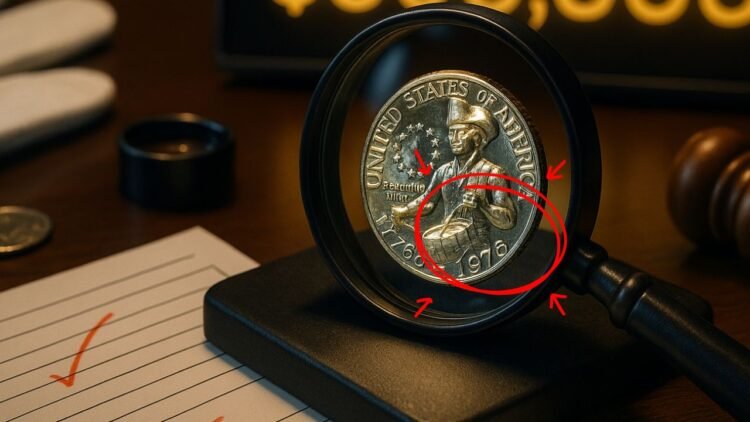The internet has been buzzing with stories about a 1976 Bicentennial quarter allegedly worth $808,888. While those jaw-dropping figures grab attention, the reality is more grounded.
Most Bicentennial quarters are worth face value, but certain rare types, mint errors, and high-grade examples can indeed sell for thousands—and in exceptional cases, tens of thousands. Knowing the exact signs to look for will help you separate hype from genuine treasure.
Why Some 1976 Quarters Are Valuable
The Bicentennial quarter was minted in honor of America’s 200th birthday. With more than 1.6 billion coins produced, most are common. But three factors can make one stand out:
- Condition (Grade): Coins graded MS67 and above can command premium prices.
- Composition: Special 40% silver proofs from the San Francisco Mint are highly collectible.
- Errors/Varieties: Off-center strikes, double dies, or missing clad layers can raise values significantly.
The Exact Signs to Spot
Here’s a simple checklist to use when examining your Bicentennial quarter:
| Feature | What to Look For | Why It Matters | Value Potential |
|---|---|---|---|
| Mintmark | “D” (Denver), none (Philadelphia), “S” (San Francisco). S silver proofs are the most sought after. | Indicates rarity and composition. | Silver proofs in top grade can fetch thousands. |
| Condition | Brilliant luster, minimal scratches, strong details on Washington’s hair and the drummer boy. | Higher grades = higher demand. | MS68 pieces can sell for thousands. |
| Composition | Silver quarters weigh more (about 5.75 g vs. 5.67 g for clad). | Silver is more valuable than clad. | Proof 70 silver coins can reach five figures. |
| Errors | Double strikes, die caps, off-center images, or missing layers. | Errors are one-of-a-kind. | Severe errors can reach tens of thousands. |
The History of the Bicentennial Quarter
The U.S. Mint created the Bicentennial design in 1975-76 to celebrate 200 years of independence. Instead of the standard eagle reverse, it featured a Colonial drummer boy designed by Dennis R. Williams. Every coin was dual-dated 1776-1976, making it unique in U.S. coinage history.
Coins were struck at Philadelphia (no mintmark), Denver (D), and San Francisco (S), with the latter producing both clad and 40% silver proof sets. Today, these coins remain beloved pieces of Americana, blending history with numismatic potential.
Realistic Value Ranges
While rumors of six-figure payouts abound, real market values are more grounded:
- Clad circulation strikes: Usually 25 cents unless in exceptional grade.
- High-grade MS68 examples: Can sell from $1,000 to $5,000+.
- Silver proofs (S mint): Typically $5–$20 in common grades, but top-grade Proof 70 examples can exceed $5,000–$10,000.
- Major errors: Dramatic off-center strikes or missing clad layers can bring tens of thousands.
How to Evaluate Your Coin
- Check the mintmark: Look for the “S” indicating proof coins.
- Inspect the condition: Avoid cleaning—scratches reduce value.
- Weigh your coin: Silver proofs weigh slightly more.
- Look for errors: Use a magnifier to spot doubling or off-center designs.
- Get professional grading: Submitting to PCGS or NGC can confirm authenticity and maximize resale value.
Where to Sell Valuable Bicentennial Quarters
- Auction Houses: Best for high-end errors and rare proofs.
- Online Platforms (eBay, Heritage, Stack’s Bowers): Attract global collectors.
- Local Coin Shops: Good for quick sales, though often at lower prices.
- Coin Shows & Clubs: Great for networking and learning about value trends.
The 1976 Bicentennial quarter is a piece of American history that millions still hold in jars, wallets, and collections. While the dream of an $808,888 payout is more myth than reality, certain silver proofs, top-graded coins, and dramatic mint errors can bring in thousands.
The key is knowing what signs to look for—mintmark, grade, composition, and errors.
So, the next time you see that drummer boy quarter, don’t dismiss it. With the right features, it could be worth far more than pocket change.
FAQs
Are all Bicentennial quarters worth money?
No. Most are worth face value unless they are in high grade, silver proof, or have a major error.
How can I tell if my Bicentennial quarter is silver?
Silver quarters weigh about 5.75 grams and were minted only at the San Francisco Mint with an “S” mintmark.
Can my Bicentennial quarter really be worth $808,888?
Not realistically. That number is clickbait. Genuine values for rare proofs and dramatic errors can reach the thousands, but not hundreds of thousands.

